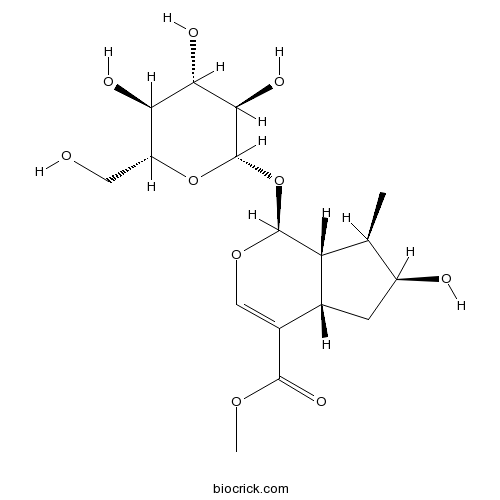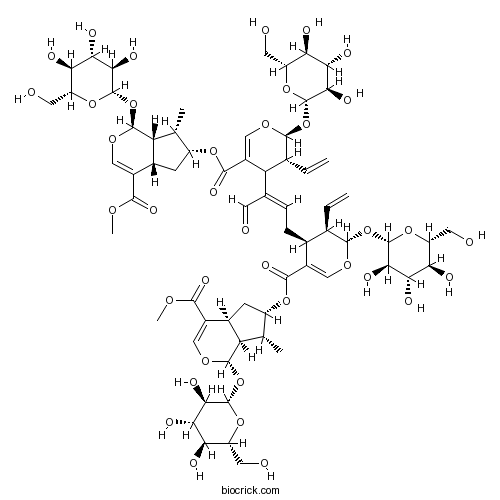Pterocephalus hookeri
Pterocephalus hookeri
1. The products in our compound library are selected from thousands of unique natural products; 2. It has the characteristics of diverse structure, diverse sources and wide coverage of activities; 3. Provide information on the activity of products from major journals, patents and research reports around the world, providing theoretical direction and research basis for further research and screening; 4. Free combination according to the type, source, target and disease of natural product; 5. The compound powder is placed in a covered tube and then discharged into a 10 x 10 cryostat; 6. Transport in ice pack or dry ice pack. Please store it at -20 °C as soon as possible after receiving the product, and use it as soon as possible after opening.
Natural products/compounds from Pterocephalus hookeri
- Cat.No. Product Name CAS Number COA
-
BCN1153
Loganin18524-94-2
Instructions

-
BCN4163
Sylvestroside I71431-22-6
Instructions

-
BCN2877
Dipsanoside A889678-62-0
Instructions

-
BCN2878
Dipsanoside B889678-64-2
Instructions

Antinociceptive and anti-inflammatory activities of a standardizedextract of bis-iridoids from Pterocephalus hookeri.[Pubmed: 29410154]
Pterocephalus hookeri (C.B. Clarke) Höeck, one of the most popular Tibetan herbs, has been widely applied in Tibetan medicine prescriptions. Chemical investigations have led to the isolation of many bis-iridoids. However, the pharmacological activities of bis-iridoid constituents of this plant have never been reported before.
[Potential distribution of the traditional Tibetan herb Pterocephalus hookeri by Maxent model].[Pubmed: 29090545]
In order to study the ecology suitability of Pterocephalus hookeri, and provide a reference for GAP planting location and regional development, the Maxent model and GIS technology were used to investigate ecology suitability regions for P. hookeri based on the distribution points collected from Chinese virtual herbarium, the references and field trips. The potential distribution areas mainly concentrated in the eastern Tibet, western Sichuan, southern Qinghai, northwest Yunnan, and southern Gansu. There were 7 major environmental factors to have obvious influence on ecology suitability distributions of P. hookeri, including altitude (contribution rate of 62%), precipitation of warmest quarter (contribution rate of 14.4%), coefficient of variation of precipitation seasonality (contribution rate of 7.2%), mean temperature of driest quarter (contribution rate of 3.5%), the electrical conductivity of top and sub-soil (contribution rate of 3%), the total exchangeable bases in the top- and subsoil (contribution rate of 2.4%) and SD of temperature seasonality (contribution rate of 2.2%). The study of the ecological suitability regionalization of P. hookeri based on Maxent model can provide scientific basis for the selection of artificial planting base and GAP planting location.
[Simultaneous determination of ten major compounds including iridoid glycosides and phenolic acids in Pterocephalus hookeri by UPLC-PDA].[Pubmed: 29052379]
This study is to develop an UPLC-PDA method for determination of 10 major components in Pterocephalus. The UPLC-PDA assay was performed on a Waters Acquity UPLCR BEH C₁₈(2.1 mm ×100 mm,1.7 μm), and the column temperature was at 30 ℃. The mobile phase consists of water containing 0.2% phosphoric acid (A) and acetonitrile (B) in gradient elution at a flow rate of 0.4 mL•min⁻¹. The detection wave length was set at 237 and 325 nm, and the injection volume was 1 μL in the UPLC system. The linear range of 10 detected compounds were good (r≥0.999 7), and the overall recoveries ranged from 96.30% to 103.0%, with the RSD ranging from 0.72% to 2.9%. The method was simple, accurate and reproducible, which can be used for the simultaneous determination of the content of ten major components in P. hookeri.
The anti-arthritic activity of total glycosides from Pterocephalus hookeri, a traditional Tibetan herbal medicine.[Pubmed: 27937009]
Pterocephalus hookeri (C. B. Clarke) Hock., a traditional Tibetan herbal medicine rich in glycosides, has been used to treat several diseases including rheumatoid arthritis.
[Study on genetic-chemical relation of Pterocephali Herba based on DNA barcode and UFLC].[Pubmed: 28871674]
DNA barcoding technique in combination with UFLC analysis technology was used to evaluate the quality of Tibetan medicine Pterocephalus hookeri from species identification and chemical qualitative and other aspects. Hybrid identification was established by DNA barcoding; UFLC-PDA was adopted to analyse fingerprint of different parts of Pterocephali Herba, and SPSS and Grey relation software were used for data analysis. The result showed that DNA barcoding is an accurate and reliable method in origin identification of Pterocephalus hookeri. The compounds in overground is more than underground by analysis of the different part fingerprint by UFLC. The genetic gene may be involved in the secondary metabolites of iridoid glycosides. Pertinence between gene and chemical component, as a new model established, could be suited for quality evaluation and resources protection.
In Vitro and In Vivo Antitumor Effects of n-Butanol Extracts of Pterocephalus hookeri on Hep3B Cancer Cell.[Pubmed: 26089933]
Pterocephalus hookeri is a widely applied Tibetan medicinal prescription for treatment of diseases such as flu, rheumatoid arthritis, and enteritis in China. It has been reported that Pterocephalus hookeri has anti-inflammatory and analgesic actions. However, the antitumor activity of Pterocephalus hookeri remains unknown. In the present study, we demonstrate that n-butanol extracts of Pterocephalus hookeri (YSC-ZDC) has a strong antitumor activity against hepatoma carcinoma cell in vitro and in vivo. YSC-ZDC inhibited proliferation of all cancer cell lines and significantly inhibited Hep3B cells proliferation in a dose- and time-dependant manner. Transmission electron microscopy, hoechst 33258 staining, and flow cytometry analysis revealed that YSC-ZDC induced apoptosis in Hep3B cells. YSC-ZDC treatment dramatically inhibited PDK1 and Akt phosphorylation in Hep3B cells. Moreover, YSC-ZDC increased Bax expression and inhibited Bcl-2 expression. In addition, YSC-ZDC inhibited growth hepatoma xenografts in vivo with no effect on body weight and spleen index. Consistent with results in vitro, YSC-ZDC increased Bax expression and inhibited Bcl-2 expression in tumor tissue. Taken together, this study shows YSC-ZDC with an antitumor activity both in vitro and in vivo. Its mechanism underlying is related to blocking of the Akt pathway and regulation of Bcl-2 family proteins expression.
Four new bis-iridoids isolated from the traditional Tibetan herb Pterocephalus hookeri.[Pubmed: 25065705]
Pterocenoids A-E (1-4), which Pterocenoids A(1) is one novel dimer containing a pyridine monoterpene alkaloid; and Pterocenoids B-E (2-4) are rare arranged non-glycosidic bis-iridoids were isolated from Pterocephlus hookeri. The structures of the compounds were established by 1D and 2D NMR spectroscopy and mass spectrometry. All bis-iridoids isolated from P. hookeri were found to possess secoiridoid/iridoid subtype skeletons. Hence, bis-iridoids can be regarded as the chemotaxonomic markers of P. hookeri. The origins of the new bis-iridoids (1-4) were postulated and their activities of inhibition of the NF-κB pathway were assayed and compounds 1-3 showed moderate activity in inhibiting NF-κB.
[Determination of loganin in Pterocephalus hookeri by HPLC].[Pubmed: 22368859]
To develop an HPLC method for determination of loganin in Pterocephalus hookeri.


